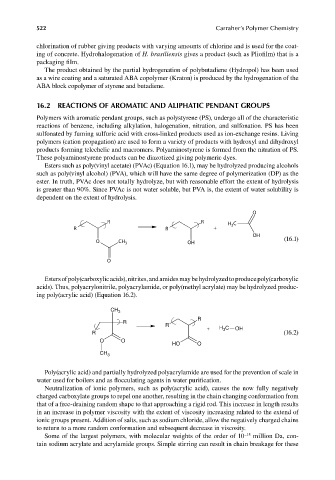Page 559 - Carrahers_Polymer_Chemistry,_Eighth_Edition
P. 559
522 Carraher’s Polymer Chemistry
chlorination of rubber giving products with varying amounts of chlorine and is used for the coat-
ing of concrete. Hydrohalogenation of H. brasiliensis gives a product (such as Pliofi lm) that is a
packaging fi lm.
The product obtained by the partial hydrogenation of polybutadiene (Hydropol) has been used
as a wire coating and a saturated ABA copolymer (Kraton) is produced by the hydrogenation of the
ABA block copolymer of styrene and butadiene.
16.2 REACTIONS OF AROMATIC AND ALIPHATIC PENDANT GROUPS
Polymers with aromatic pendant groups, such as polystyrene (PS), undergo all of the characteristic
reactions of benzene, including alkylation, halogenation, nitration, and sulfonation. PS has been
sulfonated by fuming sulfuric acid with cross-linked products used as ion-exchange resins. Living
polymers (cation propagation) are used to form a variety of products with hydroxyl and dihydroxyl
products forming telechelic and macromers. Polyaminostyrene is formed from the nitration of PS.
These polyaminostyrene products can be diazotized giving polymeric dyes.
Esters such as poly(vinyl acetate) (PVAc) (Equation 16.1), may be hydrolyzed producing alcohols
such as poly(vinyl alcohol) (PVA), which will have the same degree of polymerization (DP) as the
ester. In truth, PVAc does not totally hydrolyze, but with reasonable effort the extent of hydrolysis
is greater than 90%. Since PVAc is not water soluble, but PVA is, the extent of water solubility is
dependent on the extent of hydrolysis.
O
R R C
H 3
R R +
OH
O CH 3 OH (16.1)
O
Esters of poly(carboxylic acids), nitrites, and amides may be hydrolyzed to produce poly(carboxylic
acids). Thus, polyacrylonitrile, polyacrylamide, or poly(methyl acrylate) may be hydrolyzed produc-
ing poly(acrylic acid) (Equation 16.2).
CH 3
R
R
R
C
+ H 3 – OH
R (16.2)
O O
HO O
CH 3
Poly(acrylic acid) and partially hydrolyzed polyacrylamide are used for the prevention of scale in
water used for boilers and as flocculating agents in water purifi cation.
Neutralization of ionic polymers, such as poly(acrylic acid), causes the now fully negatively
charged carboxylate groups to repel one another, resulting in the chain changing conformation from
that of a free-draining random shape to that approaching a rigid rod. This increase in length results
in an increase in polymer viscosity with the extent of viscosity increasing related to the extend of
ionic groups present. Addition of salts, such as sodium chloride, allow the negatively charged chains
to return to a more random conformation and subsequent decrease in viscosity.
–15
Some of the largest polymers, with molecular weights of the order of 10 million Da, con-
tain sodium acrylate and acrylamide groups. Simple stirring can result in chain breakage for these
9/14/2010 3:42:50 PM
K10478.indb 522 9/14/2010 3:42:50 PM
K10478.indb 522

